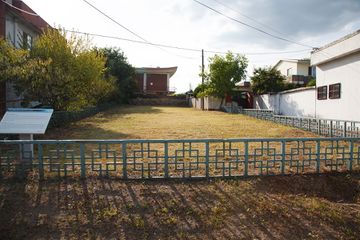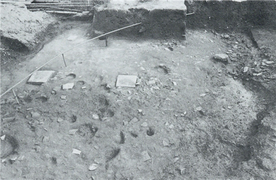부여 쌍북리 북 요지
| 부여 쌍북리 북 요지 Northern Kiln Site in Ssangbuk-ri, Buyeo |
|
 "부여 쌍북리 북 요지", 국가문화유산포털, 문화재청. |
|
| 대표명칭 | 부여 쌍북리 북 요지 |
|---|---|
| 영문명칭 | Northern Kiln Site in Ssangbuk-ri, Buyeo |
| 한자 | 扶餘 雙北里 北 窯址 |
| 주소 | 충청남도 부여군 부여읍 쌍북리 641-5번지 |
| 지정(등록) 종목 | 시도기념물 제41호 |
| 지정(등록)일 | 1982년 12월 31일 |
| 분류 | 유적건조물/산업생산/요업/토기가마 |
| 시대 | 백제 |
| 수량/면적 | 330㎡ |
| 웹사이트 | "부여 쌍북리 북 요지", 국가문화유산포털, 문화재청. |
|
|
|
해설문
국문
요지는 토기나 기와 등을 만들어 굽던 가마터를 말한다.
부소산 남쪽 기슭에 위치한 쌍북리 북요지는 백제시대 기와를 굽는 가마와 관련된 유적이다.
1982년 공사 도중 백제 사비시기 기와 조각들이 발견되어 긴급 발굴조사가 이루어졌는데, 건물의 주춧돌, 붉은색을 띠는 불에 탄 흙들과 무너진 흙벽 일부가 확인되었다. 이러한 이유로 가까운 곳에 기와를 굽던 가마가 있었고, 유적에서 건물터는 가마와 관련되는 것으로 추정되고 있다.
이 유적은 남쪽에 위치한 쌍북리 요지와 함께 사비도성 안에서 기와가 생산, 공급되는 모습을 보여주는 점에서 의의가 있다.
- 주춧돌 : 건물의 기둥을 받쳐주는 돌
영문
Northern Kiln Site in Ssangbuk-ri, Buyeo
This is a site of kilns used for the production of earthenware and roof tiles in the Baekje (18 BCE-660 CE) capital during the 6th and 7th centuries. Originally founded in Hanseong (today’s Seoul area), Baekje moved its capital to Ungjin (today’s Gongju area) in 475 and again to Sabi (today’s Buyeo area) in 538.
An excavation of this site was conducted in 1982 immediately after roof tile shards dating to the 6th-7th centuries were discovered during construction works in the area. The foundation stones of a building, baked red clay, and part of a crumbled clay wall were found in the area. A pit, approximately 100 cm in width and 15 cm in depth, was discovered in the southern part of the site and from it, black ash and a variety of roof tiles were excavated. This suggests there was a nearby kiln for firing tiles and facilities for pottery production on the site.
Together with another kiln site in Ssangbuk-ri (Historic Site No. 99), this kiln served the demand for roof tiles in the Baekje capital.
영문 해설 내용
백제가 부여 지역에 도읍을 두었던 6-7세기에 도성 내에서 토기와 기와를 굽던 가마터이다. 백제는 기원전 18년 한성(지금의 서울) 지역을 중심으로 건국되었다가, 475년에 웅진(지금의 공주) 지역으로 도읍을 옮겼고, 538년에 사비로 다시 도읍을 옮겼다.
1982년 인근 건축 공사 도중 6-7세기의 기와 조각들이 발견되어 긴급 발굴조사가 이루어졌다. 건물의 주춧돌, 불에 탄 붉은색 흙과 무너진 흙벽 일부가 확인되었다. 서쪽으로는 너비 100㎝, 깊이 15㎝ 가량의 우묵한 도랑시설이 발견되었는데, 그곳에서 검은 재와 함께 다량의 기와가 나오기도 하였다. 이로 보아 가까운 곳에 기와를 굽던 가마와 토기를 굽던 시설이 있던 것으로 보인다.
쌍북리에 있는 다른 요지(사적 제99호)와 함께 도성 안에서 기와가 생산, 공급되었던 사실을 알 수 있다.
